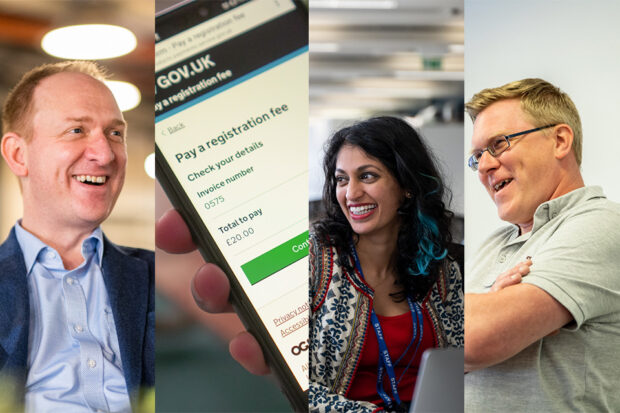
In summer 2021, we published a blogpost outlining the Government Digital Service’s (GDS) strategy for the next three years and outlined five “missions” around which we would coordinate our delivery efforts. I also noted that the strategy was a moment in time, and we expected it to change and adapt based on what we discovered.
GDS has always had a commitment to working in the open, so a little more than 18 months on, I thought it was time to reflect on what has gone well, where we have adjusted our approach, and where we are now focusing our work.
What has gone well in product
Overall, we have had a successful 18 months, and some of our achievements have gone far beyond what I thought possible.
On product, we started with an ambition to take the learnings from GOV.UK Verify and build a new digital identity and single sign-on service for all of government - something we are now calling GOV.UK One Login. Looking back, we had a mountain to climb in terms of designing and building the product set, building confidence with our customers across government, and securing funding to get it all done. The team has developed from a small group to large, high-performing team who are demonstrating user-centred, agile delivery at an extraordinary pace and scale. This success is down to a combination of a deeply talented delivery expert in our Digital Identity director, Natalie Jones, a focused and united team, and strong support from HMRC, DWP, Home Office and others across government. There is a long way to go, but we are in beta, and making real progress. We’ll be blogging more about this in the next few months.
Our exceptional GOV.UK team has developed content and new design patterns to help users navigate some of the many major events of recent times. From the response to HM Queen Elizabeth II’s death, the UK’s help for Ukraine, Cost of Living, and many others, the team have diligently worked with No.10 and colleagues right across government to make the content simple and accessible to all. Behind the scenes, they have been making GOV.UK simpler to use and navigate, improving the civil service facing publishing tools, and migrating to new web hosting infrastructure.
This year we have also made important progress on our “common tools”, which we now refer to as our “digital service platforms”. The individual platform products - like GOV.UK Notify, GOV.UK Pay and the GOV.UK Design System - have gone from strength to strength, and are mature products with ambitious development roadmaps in their own rights.
What is even more exciting is our fledgling plans to integrate these products into our newest offering, GOV.UK Forms. There are nearly 8,500 document-based forms published on GOV.UK, and most are inaccessible, put an unnecessary burden on the end user, and are expensive for government to manually process. To fix a problem of this scale, we need to go wholesale - we cannot rely on digital departments to get to every single one. Instead, we want to develop a digital “build a service” product that can be used by civil servants in operational and policy roles right across government. We’ll be talking more about this in the coming months.
What has gone well in building the GDS team

Away from delivery, we have also had a busy year of realigning the organisation to be a more focused, more inclusive, and happier place to work. There have been some considerable challenges, which I’ll get to in the next section, but overall we are in a better shape now than 18 months ago.
We have started to reintroduce internal communities of practice at GDS to create better alignment across teams, and to provide a space for professionals to share insights and develop their skills. In some areas we have gone further and centralised a small number of professions like technical architecture and cyber security. We have also set out our locations strategy, with a commitment that in addition to our existing strong foundation in London, we expand our teams in Manchester and Bristol.
Finally, we have expanded our leadership team, bringing in talent from the private sector, from other parts of government, and by promoting talent from within GDS. We have done this with a careful eye on increasing the diversity and equity of our teams, and we are moving firmly in the right direction.
Challenges and changes
The past 18 months have not been without their challenges. I won’t go into detail here, but everything from budgets to headcount has been under considerable pressure. This has meant we have had to make prioritisation decisions to make sure our people and resources are focused on the highest value areas. In the summer, we announced that we would be sunsetting our hosting platform, GOV.UK PaaS. More recently we have made the difficult decision to close both our GDS Advisory service, referred to in my previous blogpost as “GDS Expert Services” and our in-country GDS Advisory International work.
We have also made less progress than we had hoped on our plan to develop “Joined-up services that solve whole problems and span multiple departments”. While the ambition remains central to our mission, we discovered more dependencies than we had anticipated. The biggest dependency we discovered was having the GOV.UK One Login service rolled out across more services to enable a persistent, logged in user journey.
Looking forward
Recently, we’ve been doing some big thinking about our longer term ambitions for digital government in the UK, and about GDS’ role in making them a reality. We have come a long way in the past decade, and the user experience of most government services has vastly improved. However, where once the UK was world-leading, and positioned first in the UN’s e-government index, we have now slipped to 11th. We need to look to those countries who have now gone past us - Denmark, Estonia, Korea and others - and adapt our approach towards a more joined-up and proactive experience of government. We will be blogging more about this in the coming months.

About GDS
The Government Digital Service is a team of around 750 product managers, software engineers, designers, researchers, technical architects and other specialists who sit right at the heart of UK government in the Cabinet Office. We are based in London, Manchester, Bristol and in our home offices. While we are relatively small, our software products and services are used by more than 13 million people each week, and are relied upon by more than 1,900 public sector organisations across central and local government, NHS and schools.
GDS is here to make digital government simpler, clearer and faster for everyone. Good digital services are better for users, and cheaper for the taxpayer.
The core of our mission is to reduce failure demand in services and keep the user journey online. We are trying to do that in three main ways:
- ensuring a clear, easy-to-navigate and welcoming front door to government
- building common platforms to help departments make better digital services
- using our unique position at the centre of government to connect the dots
And have boiled that down into the following objectives:
- Develop the next iteration of GOV.UK as the single and trusted online destination for government information and services
- Provide a single way for people to log in to government services and prove who they are
- Build common components to make it easier for departments to build better digital services
- Connect data around users to create a faster, more personalised experience of government.


5 comments
Comment by Harmick Azarian posted on
Absolutely gutted to see the closure of the international advisory service. Having worked on initial GDS projects as part of the exemplar transformations I am now localising a service manual, design system and transformation manual for use abroad. We had some initial interactions with the advisory team for the work we are doing and they were great. We are already using the GDS approach to service design, and are using the approach for prototypes for our own one-login system. I wish that we had chance to work together properly. Wish you the best of luck.
Comment by The GDS Team posted on
Hi Harmick,
Thanks for your kind words. We’ll continue to work with overseas governments and international organisations to help research and shape good practice in digital government.
Best wishes,
The GDS Team
Comment by Tony posted on
I don't think most other digital teams will consider 750 people a small team!
Comment by simonfj posted on
Perhaps its a bit pedantic, but if we going to have a strategy statement then we should be precise.
So this should read, "“Joined-up services that solve whole problems for a (single) user by spanning multiple departments”
Comment by john mortimer posted on
“Joined-up services that solve whole problems and span multiple departments”
That's an interesting strategy, because it moves away from single transactional digital service design. When you get into that space, you will realise that there is complexity where before there was logic. The methods that are used to create transactional single services are not the same ones as those that are required for complex people centred service design. Systems thinking is required as well as alternative methods to the double diamond.
This approach has been designed for many decades in the public sector in local authorities, where there have been much success but also many failed attempts at doing this with existing service design methods. I hope that GDS is able to tap into the leading knowledge and methods that are out there to achieve this. There is no need to reinvent the wheel, nor believe that it can simply be achieved by trying harder.